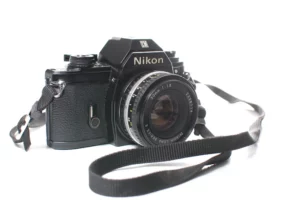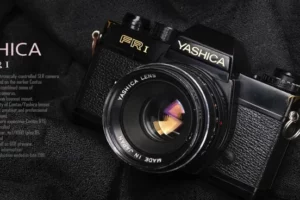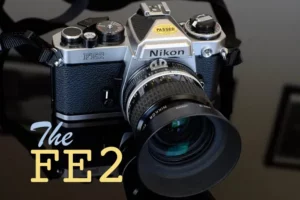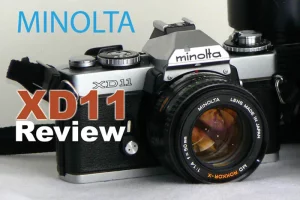Canon AE-1 Review: The camera that made everything right
Last Updated on June 10, 2023
Launched back in 1976, the Canon AE-1 broke new ground for 35mm SLR cameras by being the first camera to feature a central processing unit (CPU).
Together with a massive advertising campaign featuring renowned golfers and tennis players, the AE-1 was a huge success for Canon, selling over a million units in its eight years of operation.
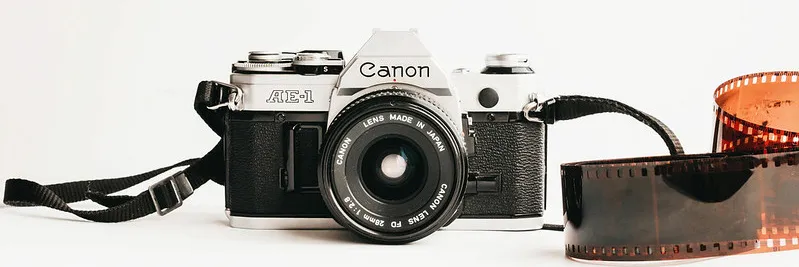
The AE-1 was also a turning point for Canon. Prior to the advent of the AE-1, Canon’s line of SLR cameras appealed primarily to amateur photographers, but the advent of the AE-1 and its electronically internals meant that Canon could offer more advanced features that were not available at this price point before.
Table of Contents
Canon AE-1 Specs
| Production: | from 1976 to 1984 |
| Finish: | Satin chrome and Black |
| Camera type: | SLR film camera |
| Film format: | 35mm |
| Exposure control: | Manual, shutter priority |
| Lens mount: | Canon FD mount |
| Shutter speed: | Mechanical 1/1000 to 2 seconds, plus bulb |
| ISO: | 25 to 3200 |
| Exposure metering: | Center weighted |
| Battery: | 4SR44 / 4LR44 6V batteries |
| Dimensions: | 141 x 87 x 47.5 mm |
| Weight: | 590 g |
History
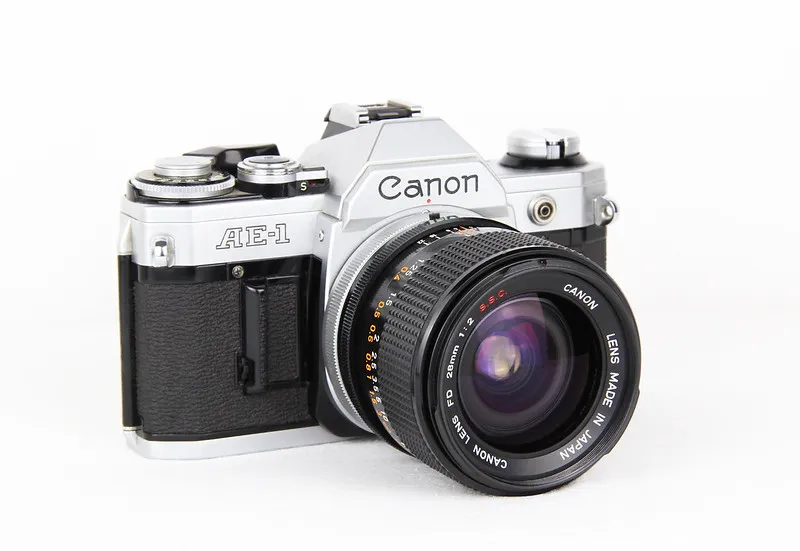
Back in 1976, Canon made history with the launch of the Canon AE-1, a groundbreaking 35mm SLR camera that pushed the boundaries of technology. Its introduction marked a significant turning point for Canon, breaking free from the shadows of Nikon’s dominance in the professional market.
Before the AE-1, Canon primarily catered to amateur photographers, unable to compete with Nikon’s stronghold on the professional market. However, Canon’s unwavering commitment to advancement led to a revolution.
By investing heavily in cutting-edge electronic control systems and implementing efficient mass production methods with new materials, Canon was able to offer the AE-1 at an unprecedented price point. This breakthrough camera integrated the first-ever central processing unit (CPU) in a 35mm SLR, providing users with advanced functionalities previously unseen at its affordability level.
Building on the success of the original AE-1, Canon launched the AE-1 Program in 1981. This updated version boasted notable enhancements, including the highly praised “Programmed Auto” mode. With this feature, photographers could rely on the camera to automatically select the optimal aperture and shutter speed based on the prevailing lighting conditions, allowing for hassle-free shooting.
In addition, the AE-1 Program exhibited a more compact and lightweight design compared to its predecessor, further enhancing its appeal to photography enthusiasts.
The CPU

With the introduction of the CPU, Canon took the opportunity to break the rule book and design the AE-1 from scratch. The AE-1 consisted of five main and twenty-five secondary nodes, allowing Canon to fully automate the production process.
This innovative approach revolutionized camera manufacturing, enabling efficient and precise production while maintaining the highest quality standards. The integration of advanced technology and automated production techniques set the AE-1 apart from its competitors and solidified Canon’s position as a leader in the industry.
AE-1 Modes
However, the AE-1 shutter priority mode was a huge advantage for more beginner photographers, as you always knew how long your shutter speed would be while the camera was adjusting aperture.
Canon went even further with the launch of the AE-1 program in 1981. The successor to the AE-1, the AE-1 program, had a program auto exposure mode in which the camera set both aperture and shutter speed.
The maximum shutter speed on the AE-1 was a little disappointing, with a maximum shutter speed of 1/1000th of a second, although the optional Canon Winder A provided motorized frame-by-frame advance to a dizzying 2fps.
Lens Mount
The AE-1 used a Canon FD lens mount, suitable for both FD lenses and the New FD mount (often referred to as FDn). Earlier FD lenses have a chrome-plated swivel ring on the bayonet, while the FDn lens is fully inserted into the camera and then rotated to lock it in place.
The 50mm kit lens
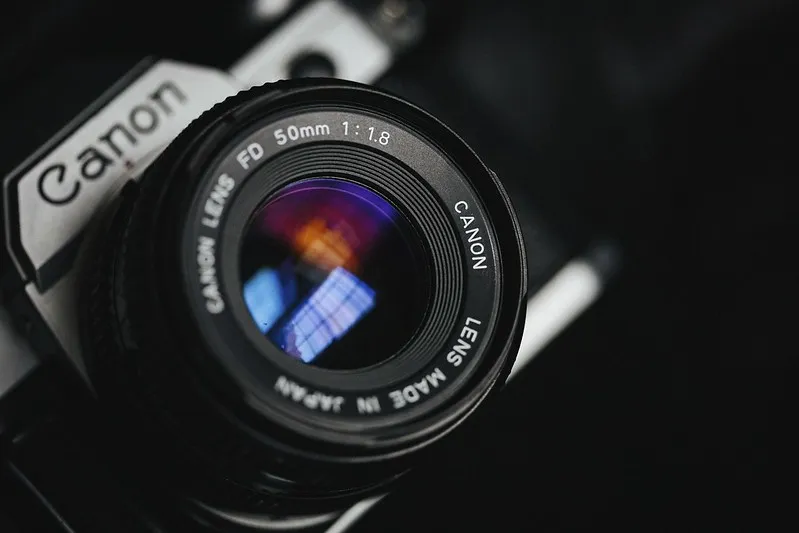
The kit lens that came with it was nothing short of the 50mm f/1.8, a versatile lens that set a standard for cameras in that range.
It was solidly constructed, primarily using metal. However, in later years, Canon transitioned to using more plastic in the construction of their entry-level 50mm lenses.
Even today, these Canon lenses have managed to cultivate a dedicated following among enthusiasts, particularly in the realm of cinema.
You should check out this fantastic report on Canon FD lenses:
The body

Looks can be a bit misleading, though, and despite its seemingly all-metal construction, the AE-1 actually incorporates a significant amount of structural plastic to keep costs low. For instance, while the top plate may give the impression of being metal, it is, in fact, an injection-molded thermoplastic polymer finished in either satin chrome or black enamel.
But don’t let this deter you, as the viewfinder remains impressively spacious. In fact, it outshines many optical viewfinders found in modern DSLRs, making them appear narrow and confined by comparison. So, while the AE-1’s use of plastic might raise an eyebrow, its generous viewfinder ensures a delightful shooting experience.
Battery
Canon AE-1 cameras, and the Program versions, are designed to be powered by either 4LR44 or 4SR44 6V batteries. Energizer’s A544 6 volt battery is one of the most popular choices, while Duracell’s offering is known as a 4A76 6V battery.
Pros and Cons
Pros
- Accurate measurement
- Lightweight
- Reliable
- Beginner-friendly
Cons
- Plasticky finish
- Maximum speed of 1/1000s (somewhat low for the time)
FAQs
How to load film in Canon AE-1?
1. To load the film, unfold the rewind crank and pull up the rewind knob firmly. This will open the camera’s back cover. Place the film cartridge into the film cartridge chamber, ensuring that the protruding part of the spool is at the bottom. Push down and rotate the rewind knob until it locks into place.
2. Next, pull the film leader across the camera and insert it into any slot of the multi-slot take-up spool, making sure it reaches at least the first perforation of the film.
3. Advance the film once, ensuring that the film sprocket holes engage with the teeth of the film transport sprocket.
4. Check that the cartridge is fully seated and the film is taut. If there is any slack, gently turn the rewind crank clockwise until it stops. Close the back cover securely. Turn the rewind crank in the direction indicated to take up any remaining slack, and then fold it back in.
5. Capture two blank shots by advancing the film lever and releasing the shutter. This will advance the frame counter from “S” to “0”. Keep an eye on the rewind knob during this process. If it rotates, the film is loaded correctly. If it doesn’t rotate, there may be film sagging or improper engagement of the film perforations with the take-up spool and film transport sprocket.
6. If the rewind knob still doesn’t rotate even after gently turning the rewind crank clockwise to take up slack, open the back cover and reload the film.
What type of film does Canon AE-1 use?
The Canon AE-1 uses 35mm film (135 format), whether it is color, black and white, or slide (reversal film).
Is the Canon AE-1 for beginners?
Yes, the Canon AE-1 is considered an ideal camera for beginners as it features the “shutter priority” automatic mode, which makes it easier to use for less experienced users.
Is Canon AE-1 still in production?
No, the Canon AE-1 ceased production in 1984, and its successor, the AE-1 Program, was manufactured until 1988.
Does the Canon AE-1 work without a battery?
No, the Canon AE-1 is an electronically controlled camera, so it requires batteries to function.
How much did the Canon AE-1 cost when it was new?
According to James McCeown’s book on classic camera prices, the AE-1 in 1976 was priced between $150-220 (adjusted for inflation, today it would be around $800-1200), with the black version costing 30% more than the chrome version.
Canon AE-1 Sample shots


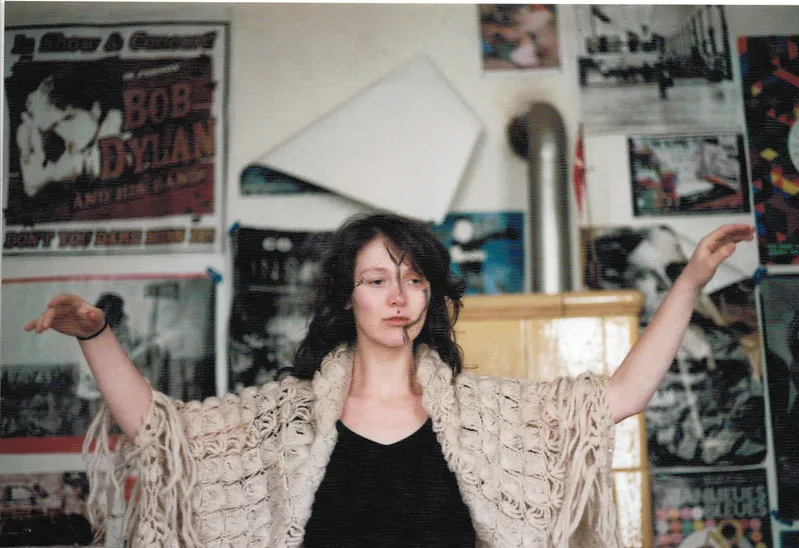

Conclusion
Since the AE-1 has proven to be incredibly popular, before you jump onto eBay, it might be worth asking relatives if they have it – you never know what might be hidden in a shoebox in the back of a closet. Otherwise, the best place to start your search is on eBay.
The good news is that it won’t break the bank – a good condition AE-1 with a 50mm f/1.8 lens shouldn’t cost you more than $150. Just be aware that a few issues can arise if not properly taken care of, such as poor light seals and a slow return of the reflex mirror resulting in a loud squeak.
The AE-1 may seem a bit primitive by today’s standards, but it played a significant role in bringing more advanced features to a wider audience. With its relatively low risk and affordable price, the Canon AE-1 is still a highly capable SLR.

Written by Jorge Ferrufino
“I am a fashion photographer and an analog photography enthusiast since the beginning of my career (15 years ago). I have had the opportunity and honor of showcasing my work in various galleries and publications around the world.“

